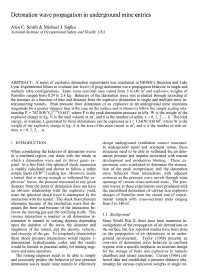Mining Publication: Detonation Wave Propagation in Underground Mine Entries
Original creation date: January 2005
A series of explosive detonation experiments was conducted in NIOSH's Bruceton and Lake Lynn Experimental Mines to evaluate low-level (<6 psig) detonation wave propagation behavior in single- and multiple-entry configurations. Entry cross-sectional area varied from 5 to 140 square meters, and explosive weights of pentolite ranged from 0.24 to 2.4 kg. Behavior of the detonation wave was evaluated through recording of the pressure as a function of time and distance from the explosive detonation in single- and multiple-entry interconnecting tunnels. Peak pressure from detonation of an explosive in an underground mine maintains magnitude for a greater distance than is the case on the surface.
Authors: AC Smith, M Sapko
Peer Reviewed Journal Article - January 2005
NIOSHTIC2 Number: 20030571
Smith AC, Sapko MJ [2005]. Detonation wave propagation in underground mine entries.J Mine Vent Soc S Afr 2005 Jan/Mar; 20-25.
See Also
- Evaluation of the Bagged Stone Dust Barrier Effectiveness in a Bord and Pillar Mine
- Exploration of Two Position Adjustment Methods for Underground Mine Tracking Systems
- Explosion Pressure Design Criteria for New Seals in U.S. Coal Mines
- Historical Development of Technologies for Controlling Methane in Underground Coal Mines
- Initial Study of Buried Communication Cable for Underground Mines
- Progress Toward Improved Engineering of Seals and Sealed Areas of Coal Mines
- Relationship Between Radiated Seismic Energy and Explosive Pressure for Controlled Methane and Coal Dust Explosions in an Underground Mine
- Rock Dusting Considerations in Underground Coal Mines
- Technology News 490 - An Inexpensive Device for Monitoring Explosions in Sealed Areas of Underground Mines
- Technology News 535 - NIOSH Releases New Educational Video: Escape from Farmington No. 9: An Oral History
- Content source: National Institute for Occupational Safety and Health, Mining Program


 ShareCompartir
ShareCompartir
